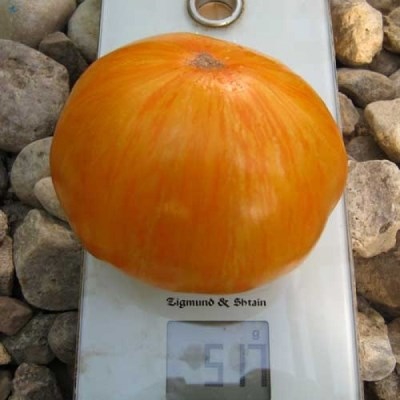
- Name synonyms: Janet's Jacinthe Jewel, Janet's Hyacinth Treasure, Janet's Pearl Hyacinth
- Category: grade
- Growth type: indeterminate
- Appointment: fresh consumption, for juice
- Ripening period: mid-season
- Marketability: high
- Bush size: tall
- Bush height, cm: 150-180
- Leaves: beautiful, potato type
- Ripe fruit color: orange with subtle light strokes and stripes
Many gardeners choose new varieties of tomatoes for themselves according to specific characteristics. Including for a beautiful and unusual appearance. Tomato Pearl Janet is one of these varieties.
Breeding history
The crop was bred in the United States, California, by breeder Brad Gates. The variety has several adapted names: Janet's Hyacinth Treasure, Janet's Pearl Hyacinth, and the American name Janet's Jacinthe Jewel.
The variety is not included in the Russian State Register, but the culture has proven itself well.
Description of the variety
The plant belongs to indeterminate varieties and has unlimited vigor. On average, the bush grows up to 150-180 cm. If you do not follow the bushes, then the stem can continue its active growth.
The trunk of the plant is thick and powerful, green in color, with characteristic pubescence. Timely tying is necessary.
It is recommended to form 1-2 stems so that they develop vigorous and adapt to unfavorable weather conditions.
The leaves are medium, small, somewhat reminiscent of potato tops. The color of the leaves is deep green. There is practically no or hardly noticeable ribbing along the edging.
The first buds are formed at the level of 7-8 leaves from the ground. Subsequent - every 2.
The advantages of the variety include:
- yield;
- size and color of fruits;
- taste qualities;
- immunity.
Of the minuses, it can be noted:
- the need for a garter;
- active growth;
- pinching;
- short shelf life;
- impossibility of whole-fruit canning;
- expensive seeds.
The main qualities of the fruit
The fruits are large, weighty, flat-round in shape. The average weight of tomatoes is from 300 to 500 g. There are also more weighty fruits of 600-800 g. Such vegetables ripen the very first and only once.
The color of the tomatoes is very interesting. The skin is pleasant orange in color with thin light longitudinal stripes. The stripes can be continuous or in the form of dashes.
The rind is smooth, firm and does not crack. There is a pronounced ribbing, which is clearly visible at the peduncle.
The variety is suitable for eating, making sauces, juices and ketchup.
Taste characteristics
Taste qualities of a tomato Pearl Janet at the height. Many people note that the taste of the fruit is sweet with a slight sourness, it refreshes and leaves behind a fruity aftertaste.
Ripening and fruiting
The culture belongs to mid-season varieties with a ripening period of 110-120 days. Harvesting is in August.
Yield
Growers have noted a stable yield. Up to 4 kg are harvested from one bush, and up to 15 kg of tomatoes can be harvested from 1 m2.
Good fruiting directly depends on the place of cultivation, weather conditions and agronomic aspects.
The timing of planting seedlings and planting in the ground
Seedling boxes are harvested before sowing. They are filled with soil mixed with fertilizers.Everything is spilled abundantly with water, and holes 2 cm deep are formed.
The seeds are soaked in melt water and then treated with potassium permanganate. After sowing, the soil is again poured abundantly with water, covered with foil and placed on the windowsill. The average room temperature should be +22 degrees. After a week, the seeds will sprout, and the film can be removed.
Tomatoes love light, so if there is not enough light and weak growth of the seedling is noticeable, it is necessary to hang a UV lamp above the seedling boxes.
A pick is done when several leaves have formed in the seedlings. Watering is done 1-2 times a week, after which fertilizers are applied.
Since the variety is indeterminate, it is necessary to monitor the growth, because the seedlings can outgrow.
You can take out seedlings outside 10-15 days before planting. The main thing is that the air temperature is warmed up to +16 degrees.
Disembarkation depends on weather conditions. If frosts are no longer observed, and the daily temperature is kept at around +14 degrees, then you can safely transplant seedlings.

Growing tomato seedlings is an extremely important process, because it largely depends on whether the gardener can harvest at all. All aspects must be taken into account, from seedbed preparation to planting in the ground.
Landing scheme
The selected area is dug up along with fertilizers. Then it is poured abundantly with water. Pits should be formed shallow -15 cm. Ammonium nitrate can be poured into the bottom of the hole to stimulate growth.
The planting pattern is staggered, 50x50 cm. This will facilitate the care of the bushes, access will be open for pinching, harvesting and good air circulation.

Growing and caring
To get a good harvest, you need to follow some rules.
- Regular watering should be done once a week. In dry times, it can be increased. On average, this is 3 liters per adult bush. All liquid should be applied directly under the root to avoid fungal diseases.
- Stepsonizing is carried out as the stepsons are formed. It is worth removing the lower leaves.
- The correct planting scheme will help to avoid overgrowth, and all the bushes will have enough sunny color.
- Top dressing should be applied 3-4 times per season. After planting, you can feed with nitrogen-containing components, and during the ovary period - with potassium and phosphorus.




A plant needs different micronutrients at each stage of growth. All fertilizers can be divided into two groups: mineral and organic.Folk remedies are often used: iodine, yeast, bird droppings, eggshells.
It is important to observe the rate and period of feeding. This also applies to folk remedies and organic fertilizers.



























































































